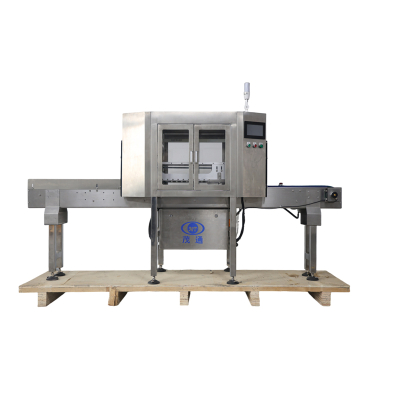Machine Vision Inspection: Technical Principles, Application Scenarios, and Future Development Trends
Introduction With the rapid development of artificial intelligence and automation technologies, machine vision inspection, as an efficient and accurate inspection method, is playing an increasingly important role in fields such as industrial manufacturing, medical diagnosis, and security monitoring. Machine vision inspection simulates the human visual system, utilizing cameras, sensors, and algorithms to identify, locate, measure, and judge target objects, greatly improving production efficiency and inspection accuracy. This article will delve into the technical principles, application scenarios, and future development trends of machine vision inspection, providing readers with a comprehensive understanding.
I. Technical Principles of Machine Vision Inspection
1.1 Image Acquisition and Preprocessing
The first step in machine vision inspection is image acquisition. Through high-resolution cameras or sensors, the system can capture image information of the target object. The acquired images are usually affected by factors such as lighting and noise, thus requiring preprocessing. Common preprocessing techniques include grayscale conversion, filtering, and edge detection, aiming to improve image quality for subsequent analysis.
1.2 Feature Extraction and Recognition
After image preprocessing, the machine vision system extracts key features from the image using algorithms. These features can be shape, color, texture, etc. Commonly used feature extraction algorithms include SIFT (Scale Invariant Feature Transform) and HOG (Histogram of Oriented Gradients). The extracted features are compared with a pre-trained model to achieve object recognition.
1.3 Data Analysis and Decision Making The core of machine vision inspection lies in data analysis. Through algorithms such as deep learning and neural networks, the system can perform in-depth analysis of the extracted features and make corresponding decisions. For example, in industrial manufacturing, machine vision systems can determine whether a product has defects; in the medical field, the system can assist doctors in identifying lesions.
1.4 Feedback and Control The ultimate goal of machine vision inspection is to provide feedback for production or decision-making. Through linkage with automated equipment, the system can achieve real-time control. For example, when a product defect is detected, the system can automatically trigger a sorting mechanism to remove the defective product.
II. Application Scenarios of Machine Vision Inspection
2.1 Industrial Manufacturing In the industrial manufacturing field, machine vision inspection is widely used in product quality inspection, production line automation, and other scenarios. For example, in automobile manufacturing, machine vision systems can detect the dimensional accuracy and surface defects of parts; in the electronics industry, the system can identify the soldering quality of circuit boards. Through machine vision inspection, companies can significantly reduce labor costs while improving inspection accuracy and production efficiency.
2.2 Medical Diagnosis
Machine vision inspection is also increasingly widely used in the medical field. For example, in medical image analysis, the system can assist doctors in identifying abnormal areas such as tumors and lesions; in surgical robots, machine vision technology can provide high-precision positioning and navigation functions. Furthermore, machine vision can also be used for pharmaceutical packaging inspection to ensure the safety and compliance of pharmaceuticals.
2.3 Security Monitoring
In the field of security monitoring, machine vision inspection technology can achieve functions such as facial recognition, behavior analysis, and license plate recognition. For example, in public places such as airports and train stations, the system can monitor crowd dynamics in real time and identify suspicious behavior; in traffic management, machine vision can automatically identify vehicles violating traffic rules, improving law enforcement efficiency.
2.4 Agriculture and Food Industry
Machine vision inspection also has wide applications in the agriculture and food industry. For example, in agricultural product sorting, the system can automatically classify products based on features such as color and shape; in food inspection, machine vision can identify foreign objects and check packaging integrity, ensuring food safety.
III. Advantages and Challenges of Machine Vision Inspection
3.1 Advantages
High Precision: Machine vision inspection can achieve micron-level precision, far exceeding manual inspection.
High Efficiency: The system can process large amounts of data in a short time, significantly improving inspection efficiency.
Non-Contact Inspection: Machine vision inspection does not require contact with the target object, avoiding physical damage.
Repeatability: Machine vision systems can maintain consistent inspection standards, reducing human error.
3.2 Challenges
Adaptability to Complex Environments: In environments with uneven lighting or complex backgrounds, the performance of machine vision systems may be affected.
Algorithm Complexity: High-precision inspection requires complex algorithms, which places high demands on computing resources.
Cost Issues: The high development cost of high-end machine vision equipment and algorithms may limit its application in small businesses.
IV. Future Development Trends of Machine Vision Inspection
4.1 Integration of Deep Learning and Artificial Intelligence
With the continuous advancement of deep learning technology, the accuracy and intelligence level of machine vision inspection will be further improved. In the future, the system will be able to better handle complex scenarios and achieve a higher level of autonomous decision-making.
4.2 Popularization of Edge Computing
Edge computing technology can distribute data processing tasks to the device end, thereby reducing reliance on cloud computing. This will significantly improve the real-time performance and response speed of machine vision inspection.
4.3 Multimodal Fusion
Future machine vision inspection systems will not only rely on image data, but will also combine data from multiple sensors such as sound, temperature, and pressure to achieve more comprehensive detection and analysis.
4.4 Industry-Customized Solutions
With the maturity of machine vision technology, customized solutions for different industries will become increasingly common. For example, dedicated image analysis systems for the medical industry, or intelligent sorting equipment for agriculture.
V. Conclusion
As an important component of artificial intelligence and automation technology, machine vision inspection is profoundly changing the production and operation methods of various industries. From industrial manufacturing to medical diagnostics, from security monitoring to agricultural sorting, the applications of machine vision inspection are constantly expanding, and its technology is continuously advancing. Despite some challenges, the future of machine vision inspection is full of potential thanks to the development of technologies such as deep learning and edge computing. Enterprises should actively embrace this technology to enhance their competitiveness and drive industry innovation.





